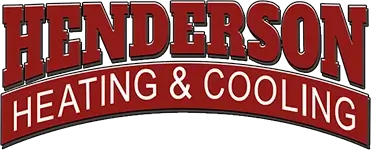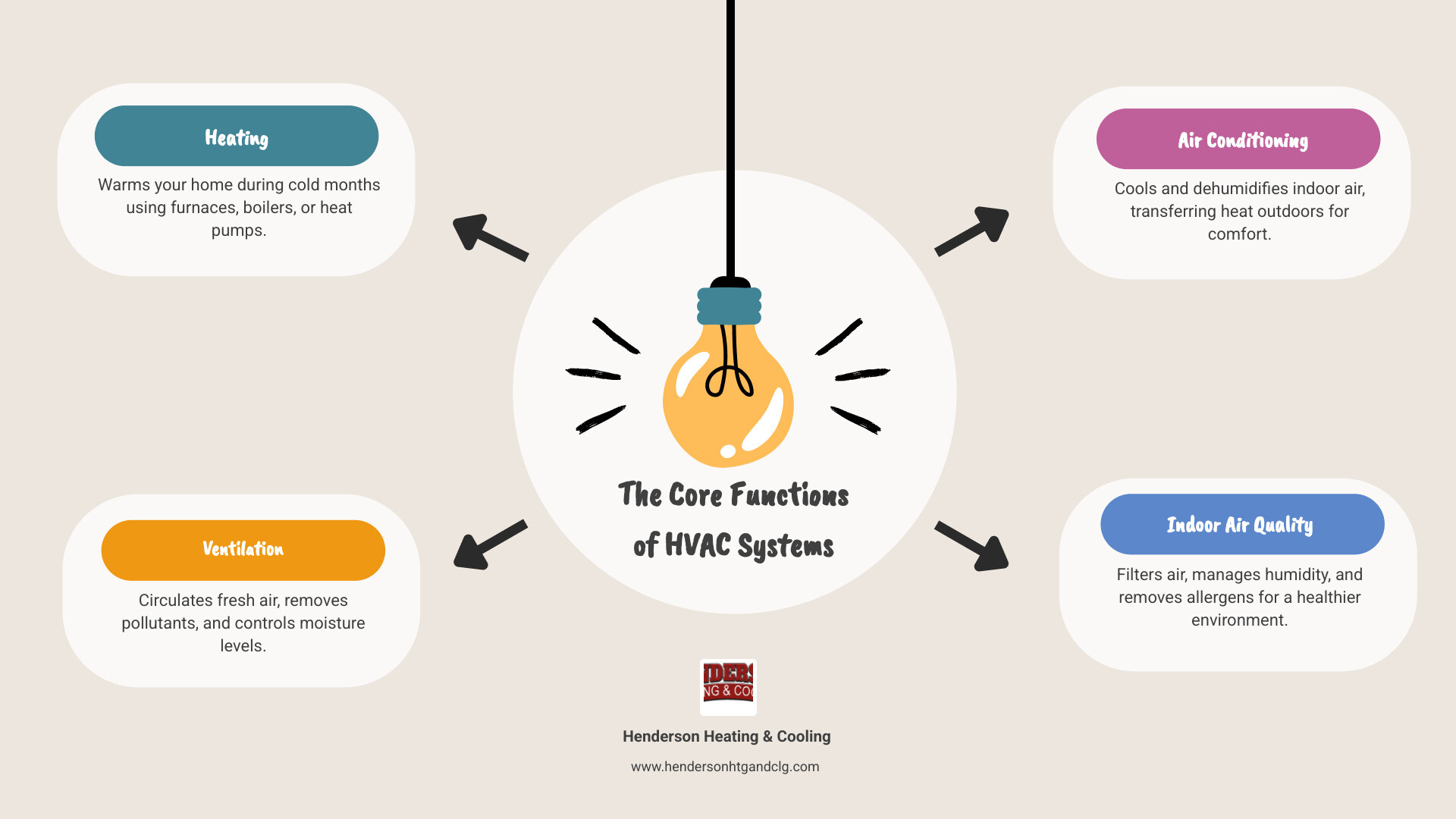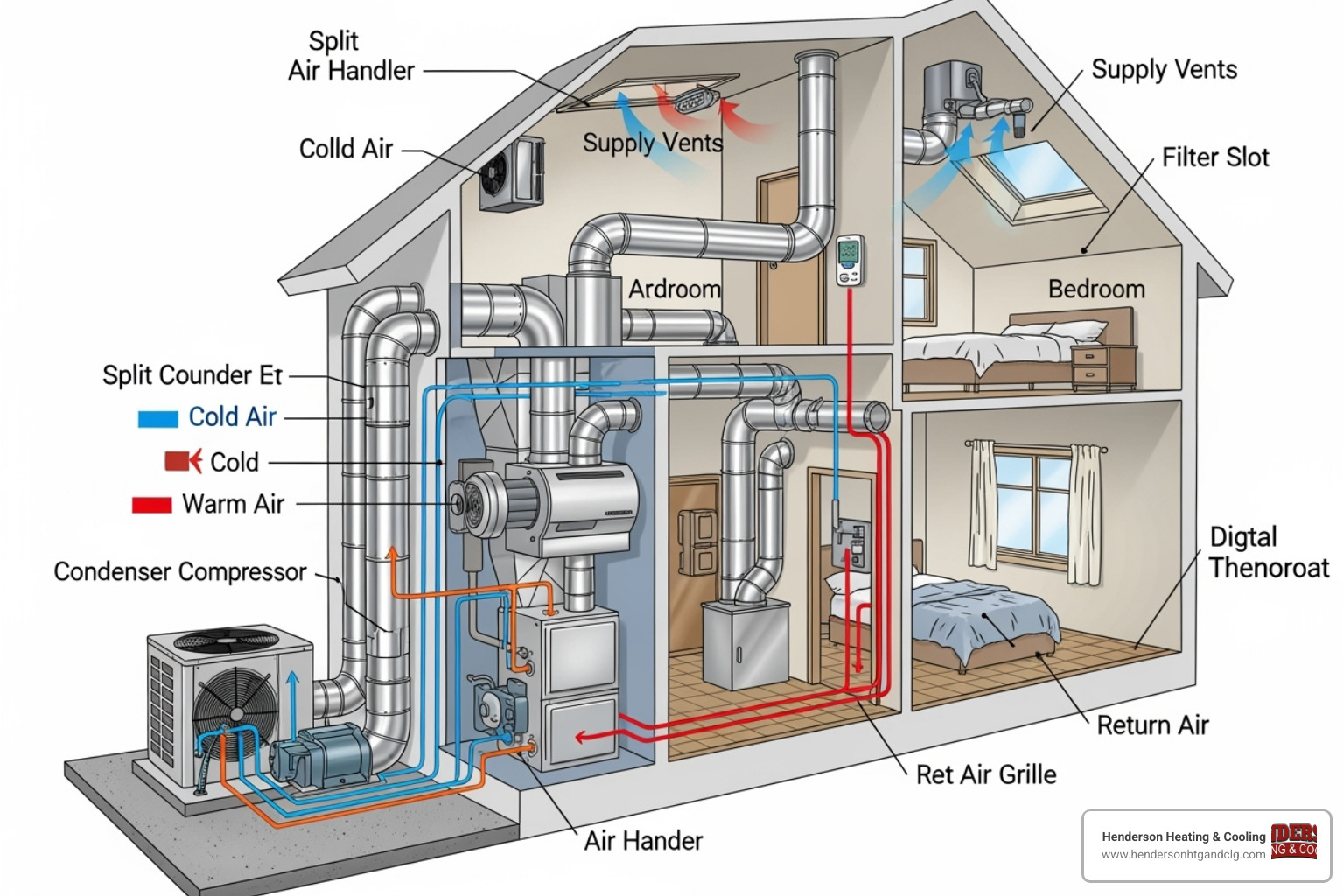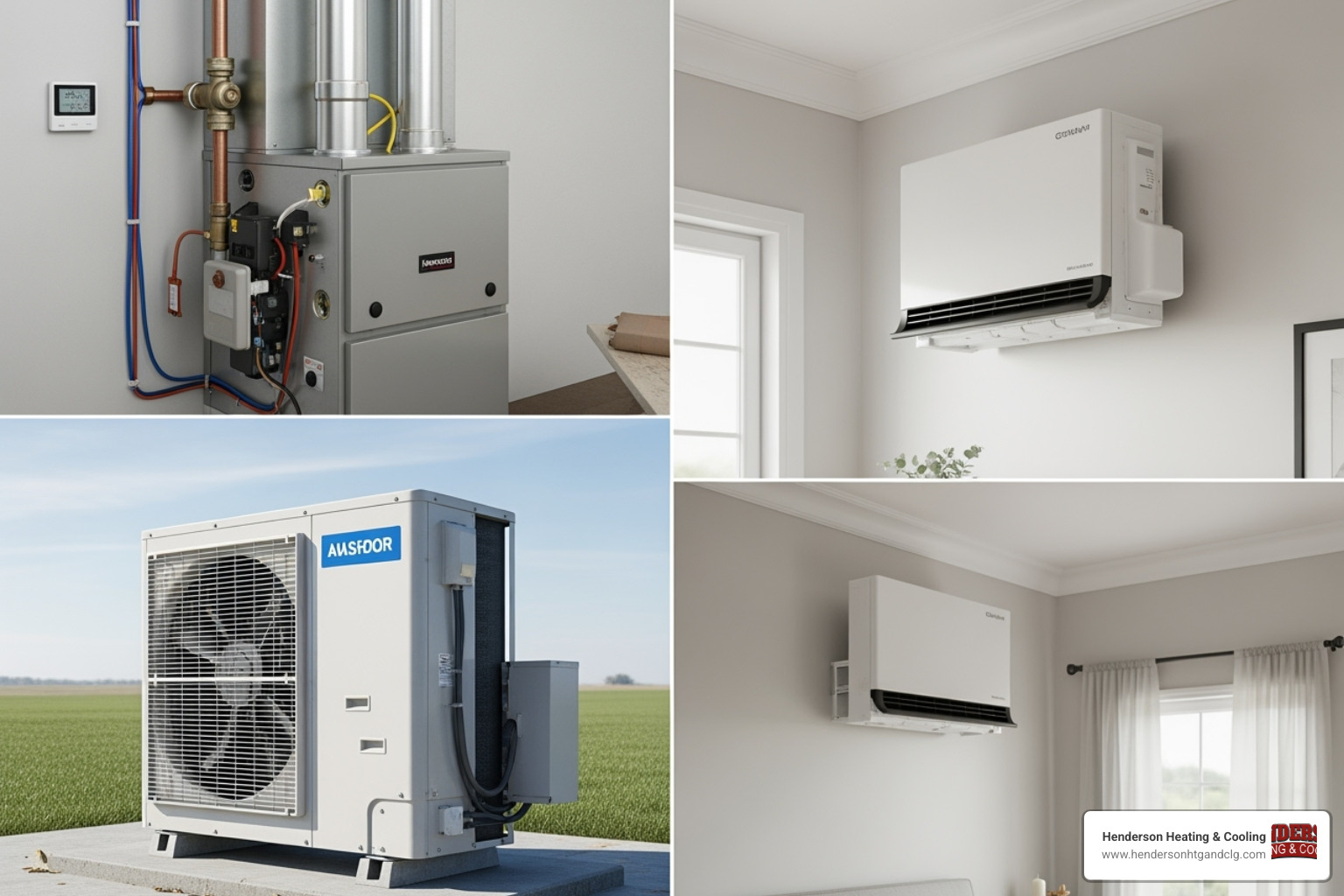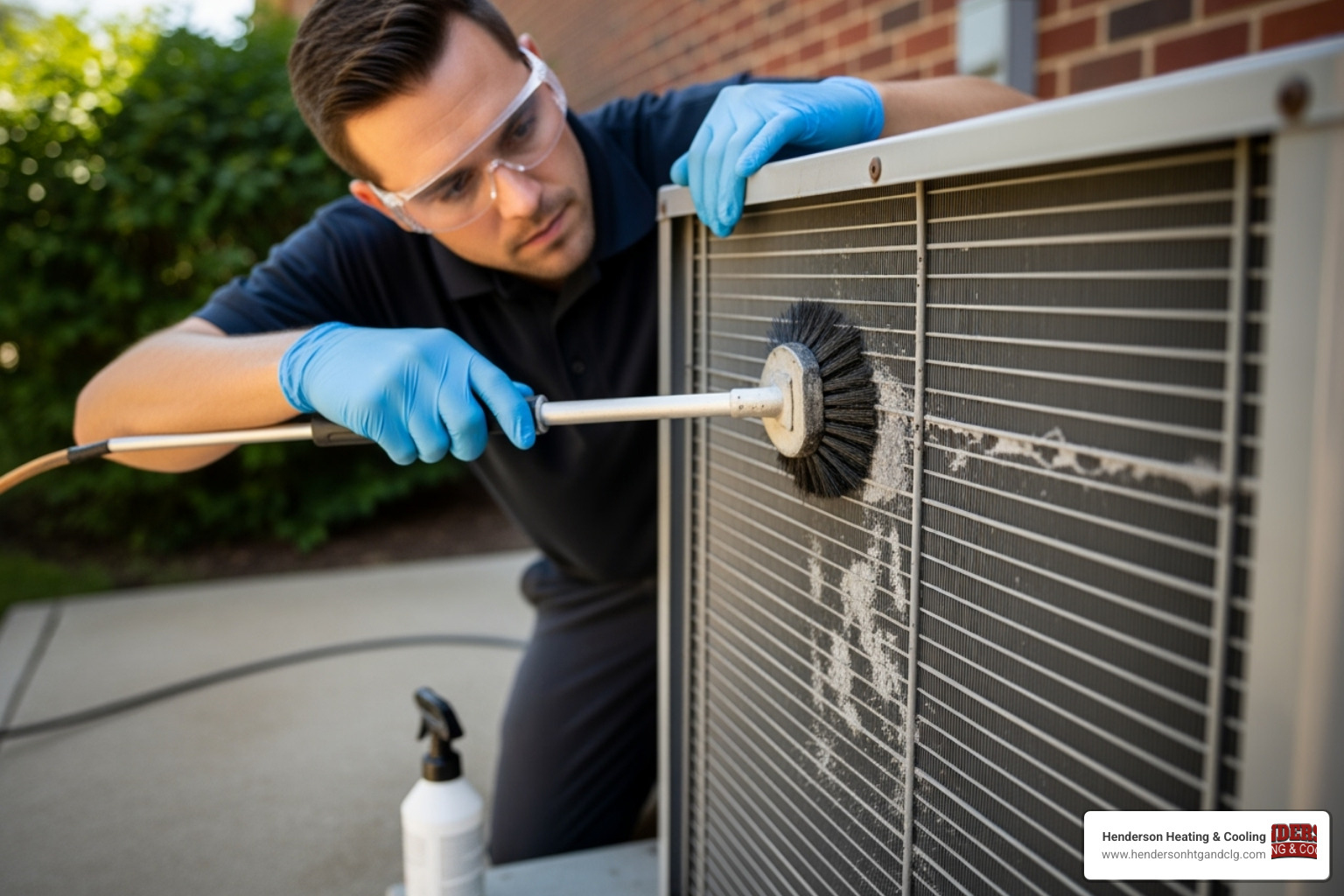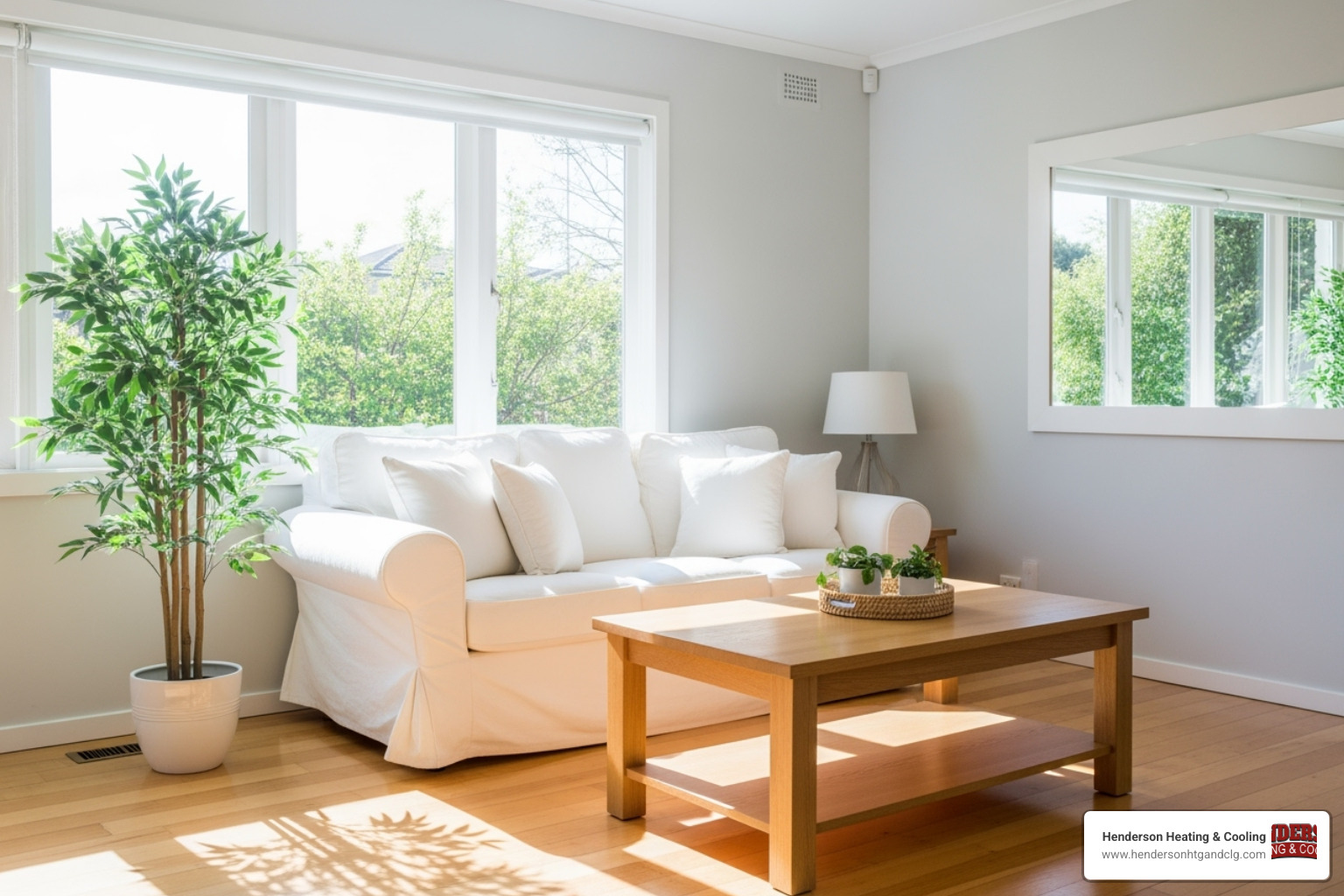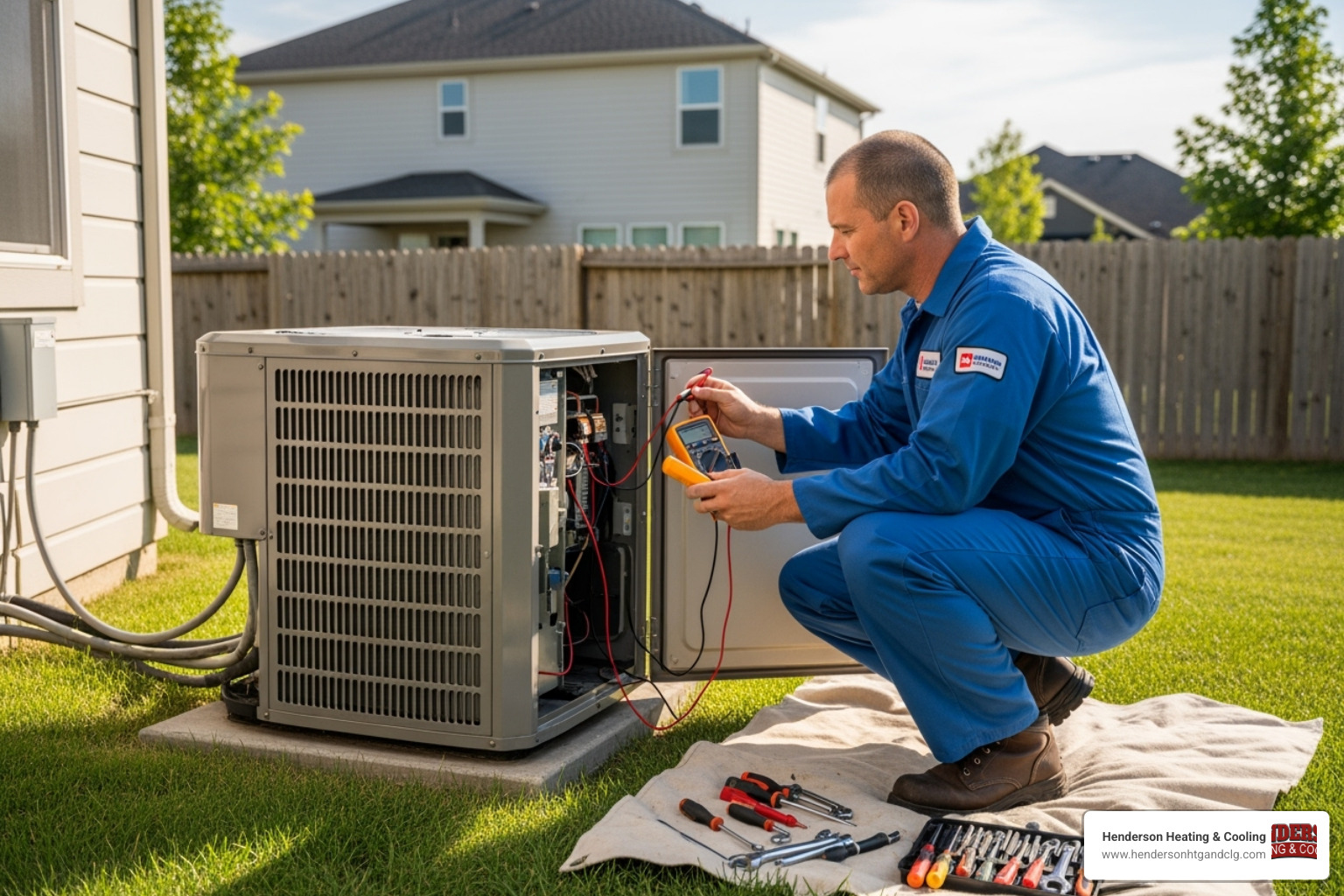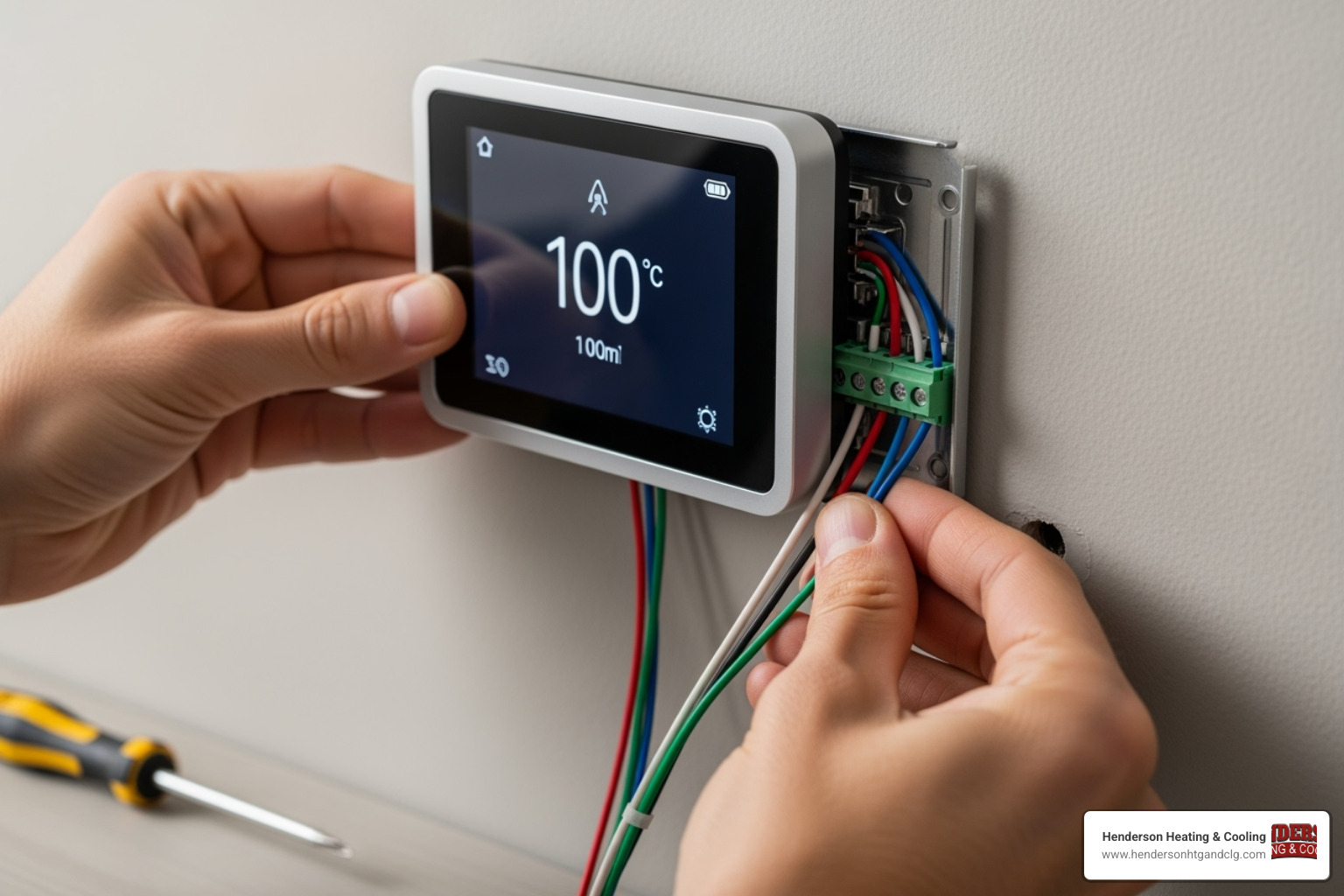What HVAC Systems Do for Your Home
HVAC systems are the unseen workhorses that keep your home comfortable year-round. HVAC stands for Heating, Ventilation, and Air Conditioning – three essential functions that work together to create the perfect indoor environment.
Quick Overview: HVAC Systems Explained
- Heating: Furnaces, boilers, or heat pumps warm your home during cold months
- Ventilation: Fresh air circulation removes pollutants and controls moisture
- Air Conditioning: Cools and dehumidifies air during hot weather
- Purpose: Maintain thermal comfort and healthy indoor air quality
- Components: Indoor unit, outdoor unit, thermostat, and ductwork (in most systems)
Your home’s HVAC system is essentially your comfort engine. It doesn’t just heat and cool – it filters air, controls humidity, and ensures proper ventilation. Think of it as the lungs of your home, constantly breathing in fresh air and removing stale air.
Modern systems have evolved far beyond simple heating and cooling. Today’s systems can provide precise temperature control, improve indoor air quality, and even connect to your smartphone for remote monitoring. Whether you’re dealing with Missouri’s humid summers or chilly winters, understanding how these systems work helps you make better decisions about maintenance, repairs, and upgrades.
The building sector accounts for one of the highest shares of global energy consumption, making efficient HVAC operation crucial not just for comfort, but also for managing energy costs. A properly maintained system can last 15 to 25 years while keeping your family comfortable and your energy bills manageable.
The Anatomy of an HVAC System
An HVAC system functions like your home’s circulatory system, with key components working together to maintain comfort. Most homes use a “split system,” with equipment both inside and outside.
- Indoor Unit: Located in a basement, attic, or closet, this unit houses the furnace or air handler, the blower fan that moves air, and the evaporator coil for cooling.
- Outdoor Unit: This contains the compressor and condenser coil, which work to release heat from your home into the outside air during the cooling process.
- Thermostat: This is the brain of the system, monitoring the temperature and telling the equipment when to turn on or off. Modern smart thermostats can learn your schedule and be controlled remotely.
- Ductwork: These channels act as a highway, delivering conditioned air to every room and returning stale air to the system.
- Refrigerant: This special fluid circulates through the system, absorbing heat from inside your home and releasing it outside.
How Air Conditioning Works
Your air conditioner doesn’t create cold air; it moves heat. Using a process called the refrigeration cycle, it pulls heat and humidity from your indoor air and transfers it outside. Warm indoor air passes over the cold evaporator coil, where the refrigerant absorbs the heat. This now-warm refrigerant is pumped to the outdoor unit, where the compressor and condenser coil work to release the heat into the outdoor air. The cooled refrigerant then cycles back inside to repeat the process, keeping you comfortable even on the hottest days.
Key Control and Distribution Components
Beyond the main units, several components are vital for control and distribution. Your thermostat is the command center, while smart thermostats offer advanced features like learning your schedule and remote access via your smartphone. Your ductwork is the delivery network, and it’s crucial that it’s well-sealed to prevent energy loss. Finally, air filters are essential for protecting your equipment and your health. They trap dust, pollen, and other particles, but they must be changed regularly. A dirty filter forces your system to work harder, reducing efficiency and potentially causing damage.
Exploring Different Types of HVAC Systems
There’s no one-size-fits-all solution for home comfort. The best setup depends on your home’s layout, your budget, and your needs. Systems are generally categorized by how they move heat: forced air (using air), hydronic (using water), or refrigerant-based. Understanding these options will help you choose the right fit for your Southwest Missouri home.
Furnaces and Boilers
These are traditional heating workhorses. Furnaces create forced hot air by burning fuel (like natural gas) to heat a component called a heat exchanger. A blower then pushes the warmed air through your ductwork. Modern furnaces are highly efficient, with ratings (AFUE) often exceeding 90%.
Boilers operate differently by heating water that circulates through pipes to radiators or in-floor tubing. This is called hydronic heating and is known for providing a comfortable, even warmth.
Heat Pumps
Heat pumps are a versatile all-in-one solution for heating and cooling. In summer, they act like an air conditioner, moving heat from inside your home to the outdoors. In winter, a reversing valve allows them to reverse the process, extracting heat from the outside air and moving it inside. Because they move heat rather than generating it, they are incredibly energy-efficient, making them ideal for Missouri’s moderate climate. For deep freezes, a dual fuel system pairs a heat pump with a gas furnace for optimal efficiency and comfort.
Ductless Mini-Splits
If your home lacks ductwork, or you want to condition a specific area like an addition, ductless mini-split systems are an excellent choice. They consist of an outdoor unit connected to one or more indoor air handlers. Each indoor unit has its own thermostat, allowing for customized temperature “zones” throughout your home. This means you only pay to heat or cool the rooms you’re using. For homeowners interested in these solutions, you can learn more about Daikin Ductless Systems.
Geothermal and Radiant Systems
For ultimate efficiency, consider these advanced options. Geothermal heat pumps use the stable temperature of the earth to heat and cool your home. A system of underground pipes exchanges heat with the ground, making these systems exceptionally efficient and environmentally friendly. You can find more information from the U.S. Department of Energy’s guide on geothermal systems.
Radiant heating warms your home by circulating hot water through tubes in the floor, walls, or ceiling. This method heats objects directly, providing a luxurious and highly efficient form of warmth.
To help you compare, here’s how these common options stack up:
| System Type | Heating Method | Cooling Method | Best For |
|---|---|---|---|
| Furnaces | Burns fuel to heat air via heat exchanger | Requires separate AC system | Homes with existing ductwork, areas with cold winters |
| Heat Pumps | Extracts heat from outdoor air | Reverses process to remove indoor heat | Moderate climates, energy-conscious homeowners |
| Ductless Systems | Individual units heat/cool specific zones | Same units provide cooling | Homes without ducts, additions, zoned comfort needs |
| Geothermal Systems | Uses stable ground temperatures | Same system reverses for cooling | Long-term efficiency goals, environmental considerations |
Each of these systems has its sweet spot, and the best choice for your home depends on factors like your existing setup, local climate conditions, and comfort preferences. The key is finding the system that matches your family’s needs and your home’s characteristics.
Maximizing Efficiency and Longevity
Proper care is essential for getting the most out of your HVAC equipment. Like a car, your system needs regular maintenance to run efficiently, prevent breakdowns, and last its full 15- to 25-year lifespan. Neglecting it can lead to costly repairs and premature replacement.
Understanding Efficiency Ratings
When shopping for systems, these ratings help you understand future energy costs:
- SEER (Seasonal Energy Efficiency Ratio): Measures cooling efficiency for air conditioners and heat pumps. A higher number means better efficiency.
- AFUE (Annual Fuel Utilization Efficiency): Measures how efficiently a furnace or boiler converts fuel to heat. A higher percentage is better.
- HSPF (Heating Seasonal Performance Factor): Measures a heat pump’s heating efficiency. Again, higher is better.
Systems with Energy Star certification standards are among the most efficient on the market and may qualify for tax credits or rebates.
Best Practices for Maintenance
Regular maintenance is the key to efficiency and a long system life.
- Change Air Filters: Check filters monthly and replace them every 1-3 months to ensure proper airflow and protect your system.
- Clean Coils: Keep both the indoor evaporator coil and outdoor condenser coil clean and free of debris to allow for efficient heat transfer.
- Clear Condensate Drains: Ensure the drain line that removes moisture is clear to prevent water damage and system shutdowns.
- Seal Ductwork: Leaky ducts can waste over 30% of your conditioned air. Professional sealing ensures air gets where it’s needed.
- Prioritize Safety: For gas furnaces, annual professional inspections and working carbon monoxide detectors are essential for safety.
For total peace of mind, consider professional maintenance plans like our HVAC Repair and Maintenance services to catch issues early.
Choosing the Right System for Your Home
Selecting the right system depends on several factors. A professional can perform a load calculation to determine the perfect fit, but key considerations include:
- Home Size and Layout: An improperly sized system will be inefficient and ineffective.
- Local Climate: Southwest Missouri’s humid summers and chilly winters require a system that can handle both extremes.
- Insulation and Air Sealing: A well-sealed home requires a smaller, more efficient system.
- Existing Ductwork: The condition and size of your current ducts will influence your options.
- Personal Needs: Consider factors like noise levels, air quality concerns, and zoning preferences.
Beyond Temperature: Air Quality, Ventilation, and Modern Innovations
Modern HVAC systems do more than just control temperature; they are crucial for maintaining a healthy indoor environment. Since we spend most of our time indoors, the quality of the air we breathe has a significant impact on our well-being. Today’s systems act as the lungs of your home, managing ventilation, humidity, and air purity.
The Role of Ventilation in Modern HVAC Systems
Ventilation is the process of replacing stale indoor air with fresh outdoor air. This is vital for diluting airborne contaminants, controlling moisture, and replenishing oxygen. While opening windows provides natural ventilation, it’s not always practical. Mechanical ventilation, managed by your HVAC system, uses fans and ducts to ensure a consistent supply of fresh air. Advanced systems like Heat Recovery Ventilators (HRVs) can do this while minimizing energy loss. For more on this topic, see the CDC guidelines on building ventilation.
Improving Indoor Air Quality
You can significantly improve your home’s air with accessories that integrate with your system.
- Air Filtration: Upgrading from a standard filter to a high-efficiency MERV-rated filter can capture smaller particles like pollen, mold spores, and bacteria.
- Humidity Control: In Southwest Missouri, our climate swings from dry winters to humid summers. A whole-house humidifier can add moisture in winter for comfort, while a dehumidifier removes excess moisture in summer to prevent stickiness and mold growth.
- Air Cleaners: For the ultimate in clean air, whole-house air cleaners use technologies like UV light or electronic precipitators to neutralize pathogens and remove microscopic particles. Explore our Indoor Air Quality services to learn more.
The Future of Home Comfort
HVAC technology is rapidly advancing, offering greater control and efficiency.
- Smart Thermostats: These devices learn your schedule, allow for remote control via your phone, and help you manage energy use more effectively.
- Zoning Systems: By dividing your home into separate temperature zones, you can customize comfort and avoid conditioning unused spaces, saving significant energy.
- Advanced Technology: Innovations like remote diagnostics allow your system to alert you and your service provider to potential issues before they become major problems. Adaptive inverter technology in high-end systems allows the compressor to adjust its speed continuously, providing precise temperature control, quiet operation, and superior energy efficiency.
Frequently Asked Questions about HVAC Systems
Here are concise answers to some of the most common questions homeowners have about HVAC systems.
What is the difference between an air conditioner and a heat pump?
An air conditioner only cools your home by moving heat from inside to outside. A heat pump is more versatile; it can cool your home in the summer and heat it in the winter by reversing the process, making it a very energy-efficient option for climates like ours in Southwest Missouri.
How often should I change my HVAC air filter?
For standard 1-inch filters, a general rule is every 1-3 months. However, check it monthly. If you have pets, smokers, or high dust levels, you’ll need to change it more frequently. A clean filter is crucial for system efficiency and longevity.
What does “zoning” mean for an HVAC system?
Zoning divides your home into different areas, or “zones,” each controlled by its own thermostat. This allows you to set different temperatures for different parts of the house, increasing comfort and saving energy by not heating or cooling unused rooms.
What are SEER and AFUE ratings, and why are they important?
These are efficiency ratings. SEER (Seasonal Energy Efficiency Ratio) measures cooling efficiency for ACs and heat pumps. AFUE (Annual Fuel Utilization Efficiency) measures heating efficiency for furnaces. In both cases, a higher number means greater energy efficiency and lower utility bills.
How can HVAC systems be made more energy-efficient?
The best methods are regular professional maintenance, consistently changing air filters, and sealing leaky ductwork. Upgrading to a smart thermostat or a zoning system also helps. Additionally, improving your home’s overall insulation and air sealing reduces the workload on your system.
What are the common dangers associated with HVAC systems?
For gas-fired equipment like furnaces, the primary danger is carbon monoxide (CO) poisoning from improper combustion or venting. It’s critical to have CO detectors and annual professional safety inspections. Other potential hazards include electrical faults and refrigerant leaks, which is why professional service is so important.
How do humidity control systems integrate with HVAC?
Whole-house humidifiers and dehumidifiers are installed directly into your ductwork. A humidifier adds moisture to the air during dry winters, while a dehumidifier removes excess moisture during humid summers. They work automatically with your HVAC system to maintain optimal humidity levels (30-50%) for improved comfort and air quality.
Your Partner in Home Comfort
Your HVAC system is truly the heartbeat of your home, working around the clock to keep you comfortable through every season. Like any hardworking piece of equipment, it deserves proper care and attention to perform its best. A well-maintained system is crucial for your family’s comfort and health, and understanding how it works empowers you to make smart decisions about its care and upkeep.
Living in Southwest Missouri, we know how demanding our climate can be on heating and cooling equipment. Our summers bring that thick, humid heat that makes you grateful for air conditioning, while our winters can deliver those bone-chilling days when your heating system becomes your best friend. Ensuring your system is ready for our region’s distinct seasons isn’t just about comfort – it’s about reliability when you need it most.
That’s where Henderson Heating & Cooling comes in. We’re not just another service company; we’re your neighbors who understand what it’s like to live through a Missouri heat wave or an unexpected cold snap. We’re dedicated to being your trusted partner in home comfort, providing the kind of reliable service that keeps your system running smoothly year after year.
We believe in doing things right the first time. That’s why we specialize in Daikin systems, which come with impressive 12-year warranties and our own Comfort Promise for your complete satisfaction. Whether you need routine maintenance, emergency repairs, or guidance on system upgrades, we’re here to help you steer home comfort with confidence.
To keep your system performing at its peak, we offer comprehensive maintenance plans designed to extend its lifespan, prevent those costly surprise breakdowns, and optimize energy efficiency. Think of it as an insurance policy for your comfort – regular care that pays dividends in reliability and peace of mind.
